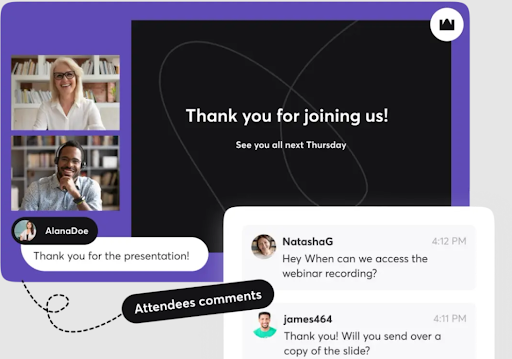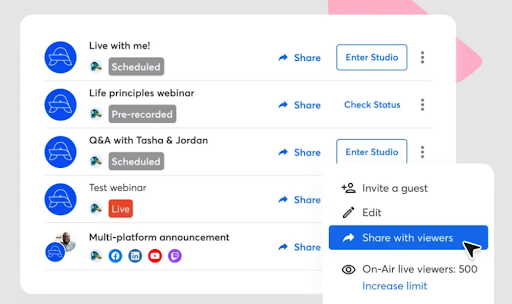Even though webinars are changing, getting people to participate is still hard. The switch to Webinar 2.0, which focuses on interactive events, brings both new opportunities and challenges.
In our complete guide, you’ll learn how to use these changes to make Webinar 2.0 more interesting.
Avoid missing out, and let’s get in now!
The Transition from Webinar 1.0 to Webinar 2.0
A webinar was typically considered as an online seminar that was one-way. However, today’s seminar, “Webinar 2.0,” is nothing of that type. This new design has made these seminars completely interactive.
Why is this important? We pushed out content in Webinar 1.0 to an audience digitally. Today’s environment needs us to push content to audiences in a much more engaging way using a competitive platform for streaming live.
The purpose of Webinar 2.0 here is to create real-time interaction. What it does is make the experience that participants have an interactive one.
Rather than just listening, Webinar 2.0 is the type of session where the conversation is held, ideas are exchanged, and in numerous cases, participants collaborate in real-time. The reason is that when this happens, keeping an audience’s attention is more challenging, which is the real value.
Here are some important features of Webinar 2.0:
- Interactivity – The audience and presenters can interact with each other in real time.
- Collaboration – Tools that allow real-time collaboration, such as shared whiteboards.
- Engagement Tools – Things that allow participants to be engaged, such as polls, quizzes, and Q&A sessions.
- Personalization – Being able to tailor a webinar experience to individual participants.
- Analytics – The ability to get real-time analytics back to see how engaged the participant is and whether the session was practical.
Webinar 2.0 is briefly explained here. Based on webinar goals and needs, implementation can differ significantly.
5 Strategies For Audience Engagement In Webinar 2.0

Alt text: Strategies For Audience Engagement In Webinar 2.0
Engaging the audience is critical for the success of a webinar. In the age of Webinar 2.0, which lays enormous emphasis on interactivity and collaboration, here are five strategies to increase audience engagement:
Engage the Audience with Interactive Tools:
Interactive tools are the core of Webinar 2.0. They convert the webinar from a one-way presentation to a two-way conversation. For instance, a live poll can be used to take the audience’s pulse on a topic immediately. It keeps the audience engaged and gives the presenter valuable insights in real-time. Similarly, a quiz can be used to gauge how well the audience has understood the material presented. These tools make the webinar more interactive and engaging, producing a richer learning experience.
Let the Audience Collaborate in Real-Time:
Webinar 2.0 platforms usually come with features that allow for real-time collaboration. For example, breakout rooms allow participants to break off into smaller groups for deep dives. They can be particularly valuable for complex topics that benefit from brainstorming or problem-solving. Shared whiteboards can be utilized for group doodling or note-taking. They make the webinar feel more like an in-person meeting, which can help foster a sense of community among the participants.
Host Excellent Q&A Sessions:
Q&A sessions are an excellent way to engage the audience. It gives them the chance to ask questions, get clarifications, and contribute to the conversation. To manage them well, it’s usually a good idea to have a dedicated Q&A moderator. The moderator can keep track of the questions being asked, make sure that they’re all answered, and keep things moving along. It ensures that the Q&A session is interesting, enjoyable, and engaging for everyone.
Personalization:
Personalization is all about tailoring the lineup to the interests and needs of each participant. This can be as simple as directing comments to participants by name or as complex as providing learning resources tailored to the needs of each audience-member interest. This makes participants feel that their participation is of vital value and increases their commitment and buy-in to the Webinar 2.0 experience.
Engagement Analytics:
Evaluating whether participants have experienced the lineup is helpful information. How do you incorporate interactivity to enhance their expertise? These analytics reveal how users interact with webinar content, what parts of the lineup appeal in full or in part, and when and when to do so. Interactive ranking analytics such as these are invaluable for improving future webinars.
Given the potential to turn your webinar into an active learning experience, these strategies can significantly improve audience engagement in Webinar 2.0, make it more FUN for them, and boost the effectiveness of any event or event-based certification that underscores your products and services!
Challenges and Solutions

Alt text: Challenges and Solutions of Webinar 2.0
Implementing Webinar 2.0 can be a challenge. From a technological perspective, it’s common for not everyone to have a stable internet connection and the hardware necessary to participate actively in an interactive webinar like this. This would limit the attendee’s participation and the host’s ability to engage both with the content and other participants.
The second challenge is the learning curve of new technologies. Many people aren’t as fast to pick up on something as they wish. And finally, keeping the audience engaged has always been difficult since they have the world to distract them.
It is, however, possible to overcome these challenges and gain the wins of adoption. There are solutions and best practices at each stage. As an example, if the technological barrier is a big concern, then you should pick a webinar platform that is accessible and very low on system requirements. If you’re worried about the participant having learned many new technologies, then you include training materials and available technical support.
As for keeping the audience’s attention, using a lot of movement and a set of interactive elements will keep them moving, and the relevant content will keep them involved.
The future of audience engagement in webinars is bright.
There will likely be a future where these webinars use VR or AR technology that allows the hosts to let attendees be nearly as close to or far from the front, back, side, and even top of the room as they choose. The market will also likely include an AI that’ll allow the system to remember what the participant did last time he was on a program and figure out other considerations.
Conclusion
The bottom line is that while it’s complex or challenging to implement, it’s possible today to do Webinar 2.0. By integrating it into a low-cost, technically reliable, and effective solution, your webinar can quickly provide value to the attendees, as was always the case.






